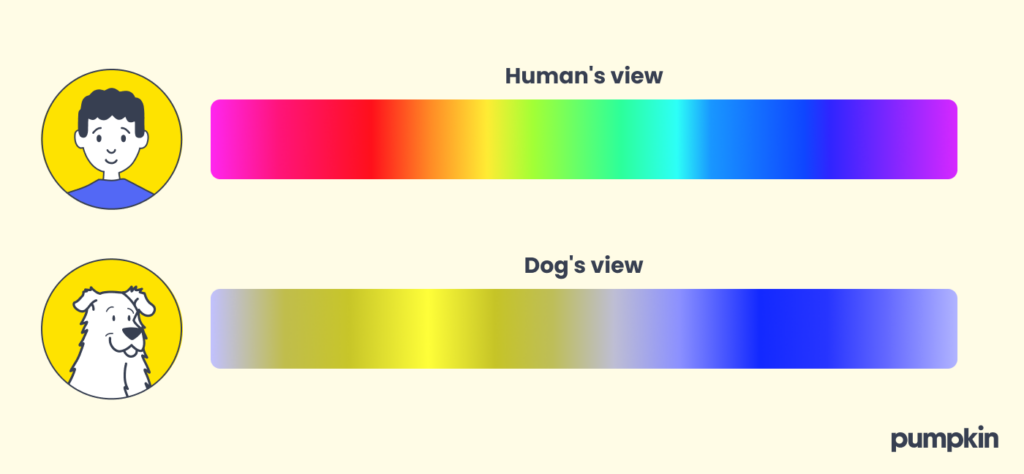Key Points:
- Dogs see muted colors with slightly blurry details, and only two primary colors: blue and yellow.
- Dog’s eyes work well in low light, meaning they have far better night vision than humans.
- Your dog’s breed can affect their vision.
There are certain “facts” that we’ve been told about dogs. For instance, you’ve probably heard someone say that one dog year equals seven human years. In the same way, you may have grown up believing that dogs see the world in black and white.
So, can dogs see color? Or does the world look like a classic black-and-white movie to them?
Science has proven that yes, dogs see colors, but not as many or with the same visual acuity as humans.
When you understand how your pup perceives color, you can choose the right toys and create a more engaging environment for them. Let’s dive into the fascinating world of canine vision and the colors dogs can see.
Human vs. dog vision
The anatomy of the eyes determines how a species sees the world.
It all starts with the retina in the back of the eye. It converts light into electrical signals that travel to the brain through the optic nerve. Once there, the brain forms those signals into the images we see, including color perception.
Colors are different wavelengths of light reflected by an object. How we see those colors is determined by the nerve cells, or color receptors, in our retinas. These color receptors are called cones and rods.
Cones work in the bright light spectrum and control the perception of color. Humans have three cones, letting us see all the colors of a rainbow. We call this type of vision trichromatic, and it allows us to see primary colors red, blue, and green and the different shades of each. (Humans can’t perceive ultraviolet light, though some animals can.)
Dogs have only two cones, allowing them to see only two primary colors: blue and yellow. This is called dichromatic vision. Dichromacy is a type of color blindness in humans, which results in the inability to distinguish between red and green.

What colors can dogs see best?
Dogs see the world primarily in yellow and blue. They can easily distinguish between these colors and different shades of them. Since they have dichromatic vision, their perception is limited compared to that of humans.
What colors can dogs not see?
Dogs can’t see reds and greens in the same way humans can. Their color vision can be compared to a person with red-green color blindness. This means they can’t distinguish red from green and instead see these colors as a muddy yellow, brown, gray, or even black.
A comparison of how colors appear to dogs vs people:
- Red objects: In your dog’s eye, red appears as dark brownish gray or black.
- Green objects: They see green objects as grayish or brown. They also can’t distinguish red from green.
- Blue objects: Dogs see blue really well.
- Yellow objects: Yellow, orange, and green look yellowish.
- Purple objects: Purple looks the same as blue.
Can dogs see in the dark?
Yes, dogs can see in the dark and are considered to have excellent night vision.
We’ve talked about cones, but rods are cells that can detect the smallest movement even in low light. Humans don’t see well in low light because we only have one rod, whereas dogs have two.
Dogs also have pupils that dilate wider, a bigger lens, and a larger corneal surface. A reflective lens behind the retina called the tapetum lucidum reflects all the light in the darkness, giving your dog even stronger night vision. If you’ve ever seen an animal with glowing eyes peering at you in the dark, that glow is the tapetum lucidum reflecting the surrounding light.
What colors can dogs see in the dark?
While a dog’s ability to perceive color diminishes as light levels drop, they still see yellows and blues better in low-light conditions.
Also, consider that dogs have far superior hearing and smell to humans along with excellent night vision. So, they can use their night vision and other senses to navigate in the dark. While humans primarily navigate the world using vision, dogs can rely more on their senses of smell and sound.
What does dog vision look like?
To visualize how a dog sees the world, think of it this way:
- Humans: We see bright, vibrant colors and sharp details in a narrower field.
- Dogs: They see muted colors and slightly blurry details with a wider field of view.
Dog’s sharpness of vision is different, too
Dogs are nearsighted, meaning they can’t see as far away as we can. But they have much better peripheral vision. Because their eyes are more toward the sides of their heads, they see 250-degree views, whereas we see 60-degree views.
While we can see clearly all around us, our dogs cannot. Your dog’s best vision is directly in front of them, and their visual field is more blurry than yours.
What color toys are best for dogs?
Even though your pup can’t distinguish the subtleties of light blue shades, dogs aren’t color blind. This may explain why they eagerly chase that yellow tennis ball and show no interest in the red one. (If you’re wondering why your dog can always find his yellow tennis ball in the sea of tennis balls at the dog park, it’s because of his superior sense of smell.)
It may be worthwhile to look at the colors of your dog’s toys and see if the blue and yellow ones are more loved because your pup can see them better.
Here are the same toys as seen through the lens of a human vs. a dog:

Does breed affect dog vision?
Your dog’s breed can affect their vision in various ways, too.
Eye shape and structure: Breeds like the Pug, Pekingese, and Bulldog have bulging, prominent eyes that are more prone to injuries and conditions like corneal ulcers. This can affect their vision.
Field of vision: Breeds with longer snouts, like a Greyhound, tend to have a wider field of vision than short-snout breeds like a Pug.
Genetic eye disorders: Some dog breeds are more prone to hereditary eye diseases. For example, breeds like the Cocker Spaniel and Poodle are prone to cataracts, while Progressive Retinal Atrophy (PRA) is found in dogs like Labrador Retrievers. These conditions can have a big impact on their vision.
Hunting, working, and herding breeds: Dogs bred for specific tasks have visual adaptations suited to those tasks. For example, the Greyhound has excellent motion detection and a wider field of vision to help chase prey.
Myths about dogs and their vision
Here are some of the biggest myths about dog vision.
1. Dog vision is just like human vision but blurred
Dogs’ vision differs from ours in several key ways beyond blurriness. They see fewer colors, have far better night vision and motion detection, and generally have a wider field of view, depending on the breed.
2. Dogs see only in black and white
Dogs don’t only see in black and white. Instead, they can see specific colors. They have dichromatic vision, meaning they see blues and yellows really well but only see reds and greens in shades of browns and grays.
3. Dogs are color-blind
In human eyes, color blindness is an abnormality in the color-detecting molecules. Some people who are considered color-blind can’t distinguish colors outside the red-green spectrum, and others can’t distinguish colors outside the blue-yellow spectrum.
Dogs fall on the red-green color blindness spectrum, and they can’t see green grass or a bright red rose as vividly.
So, can dogs see colors like we can?
Dogs don’t see color the way humans do. However, they also don’t see colors in black and white. Instead, the colors they see are limited to yellow and blue, which is why you can use yellow and blue toys to train your dog (like, say, tennis balls).
Understanding your pup from tip to tail can help make sure they stay healthy and keep you aware when something seems off. Learn more about how having a Pumpkin pet insurance plan in place can help make eligible vet visits more wallet-friendly in the future.
Dogs, color, and vision: FAQs
- https://www.verywellmind.com/what-is-the-trichromatic-theory-of-color-vision-2795831
- https://medical-dictionary.thefreedictionary.com/dichromatic+vision
- https://www.nei.nih.gov/learn-about-eye-health/eye-conditions-and-diseases/color-blindness/types-color-vision-deficiency
- https://www.sciencedirect.com/topics/veterinary-science-and-veterinary-medicine/tapetum-lucidum
- https://www.ncbi.nlm.nih.gov/pmc/articles/PMC4430292/
- https://vcahospitals.com/know-your-pet/cataracts-in-dogs#
- https://www.greyhoundclubofamericainc.org/eyes-have-it




